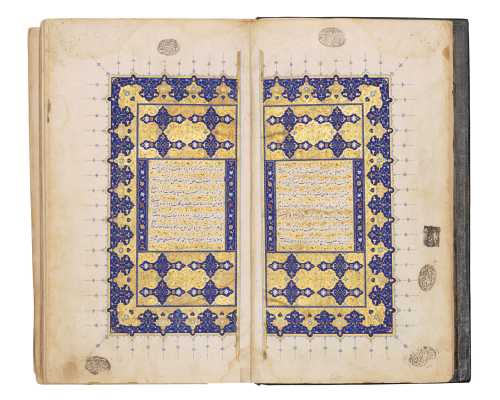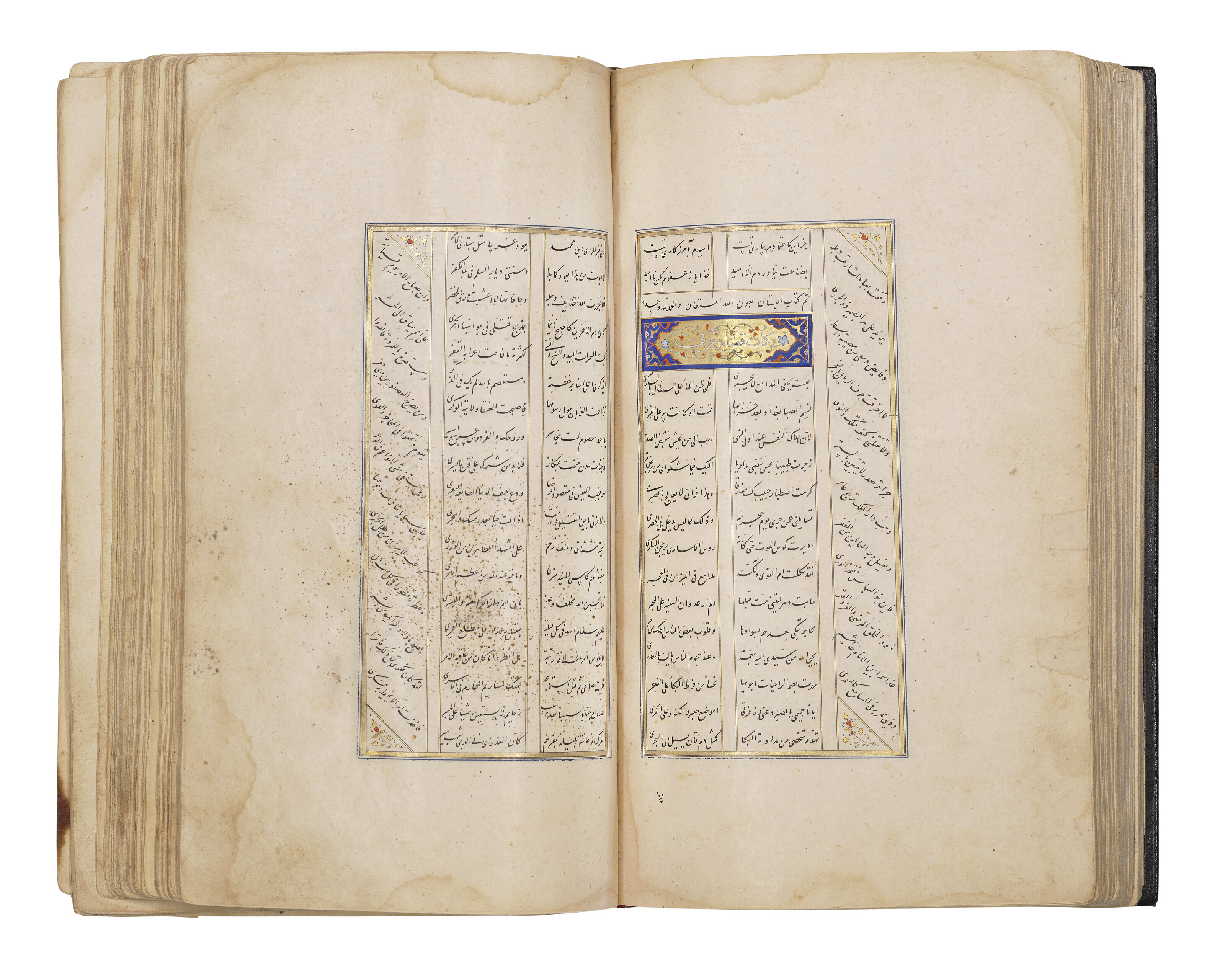- SHAYKH MUSLIH AL-DIN SA’DI (D. 1292): KULLIYAT 1496
- Handicrafts and classics, Calligraphy, manuscript
- 17.8 * 29.9 cm
- SIGNED 'ABDULLAH AL-SAMADI, TIMURID IRAN, DATED 18 DHU'L-QA'DA AH 901⁄6 AUGUST 1496 AD
Poetry, Persian manuscript on paper, 395ff., plus two flyleaves, 19ll. of black nasta'liq variously arranged in one or two columns within double gold intercolumnar rules, flanked by a column with 12ll. of nasta'liq written on the diagonal, gold and polychrome illuminated triangular cartouches above and below, keywords picked out in gold, red and blue, headings in white thuluth on gold and polychrome illuminated panels, within gold, black and blue rules, catchwords, opening bifolio illuminated in gold and polychrome framing 7ll. in clouds reserved against a gold ground, with later owners' seal impressions, colophon signed and dated, in contemporaneous gilt-stamped and découpé binding, in stamped box with flap
Estimation
£6,000
7,897 USD
-
£8,000
10,529 USD
Realized Price
£30,240
39,800 USD
332%
Artwork Description
Given the exquisite quality of the opening illumination of this manuscript, it is unsurprising that the illumination of Timurid and Safavid Persia would serve as inspiration for other centres, particularly the Ottomans. The illuminator has masterfully chosen a particularly rich layer of lapus lazuli creating a dazzling ultramarine shade, heightened by its contrast with the cartouches of block gold.
Under Mehmet the Conqueror, artistic commissions looked to Turkic, Perso-Islamic, and Byzantine inspiration, and after the Ottoman conquest of the Safavids, there was an increased presence of Iranian artists in the Ottoman court. Both in its rich blue tone and layout, the illumination of this manuscript is comparable to an Ottoman Qur'an from the first half of the sixteenth century sold in these Rooms, 5 October 2010, lot 306, and another in the Museum of Turkish and Islamic Arts, Istanbul (inv.no.TIEM 224). This characteristic bright lapis lazuli would go on to become a mainstay of Ottoman illumination. Although the illumination in the opening bifolio relates to Ottoman production, the illumination within the manuscript, such as the gold floral cartouches framing the text, is typical of Persian illumination.
Under Mehmet the Conqueror, artistic commissions looked to Turkic, Perso-Islamic, and Byzantine inspiration, and after the Ottoman conquest of the Safavids, there was an increased presence of Iranian artists in the Ottoman court. Both in its rich blue tone and layout, the illumination of this manuscript is comparable to an Ottoman Qur'an from the first half of the sixteenth century sold in these Rooms, 5 October 2010, lot 306, and another in the Museum of Turkish and Islamic Arts, Istanbul (inv.no.TIEM 224). This characteristic bright lapis lazuli would go on to become a mainstay of Ottoman illumination. Although the illumination in the opening bifolio relates to Ottoman production, the illumination within the manuscript, such as the gold floral cartouches framing the text, is typical of Persian illumination.
More lots by Unknown Artist
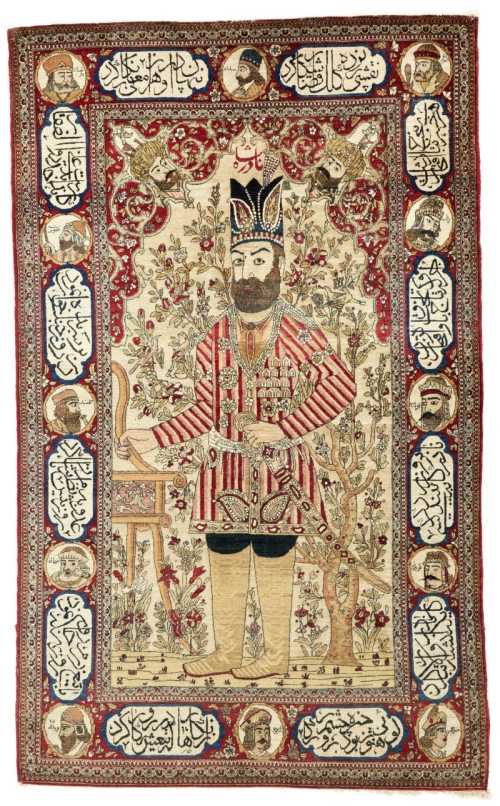
An Isfahan pictorial rug, Central Persia, circa 1910
Estimation
£4,000
5,236 USD
-
£6,000
7,853 USD
Realized Price
£5,670
7,421 USD
13.4%
Sale Date
Sotheby's
-
30 March 2022

A gold medal commemorating the coronation of Muhammad Reza Shah and Queen Farah
Estimation
£100
132 USD
-
£200
263 USD
Realized Price
£160
211 USD
6.667%
Sell at
Sale Date
Rosebery's Auction
-
1 April 2022
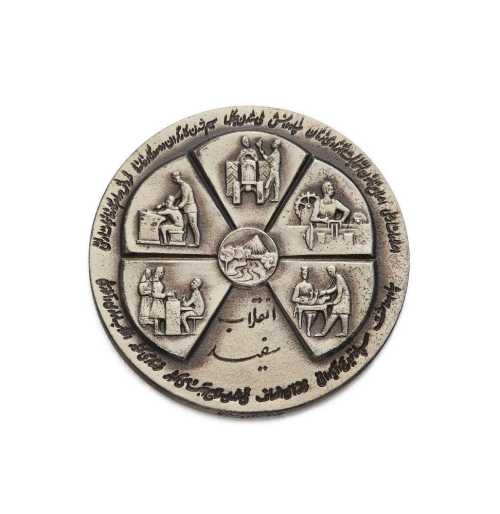
A silver memorial medal of the White Revolution, Muhammad Reza Shah, 1967
Estimation
£200
263 USD
-
£300
395 USD
Realized Price
£170
224 USD
32%
Sell at
Sale Date
Rosebery's Auction
-
1 April 2022
Realized Price
67,245 USD
Min Estimate
35,481 USD
Max Estimate
53,247 USD
Average Artwork Worth
+83.63%
Average Growth of Artwork Worth
Sales Performance Against Estimates
Average & Median Sold Lot Value
2021 - 2025
Performance vs. Estimate
2021 - 2025
Sell-through Rate
2021 - 2025
Similar Artworks
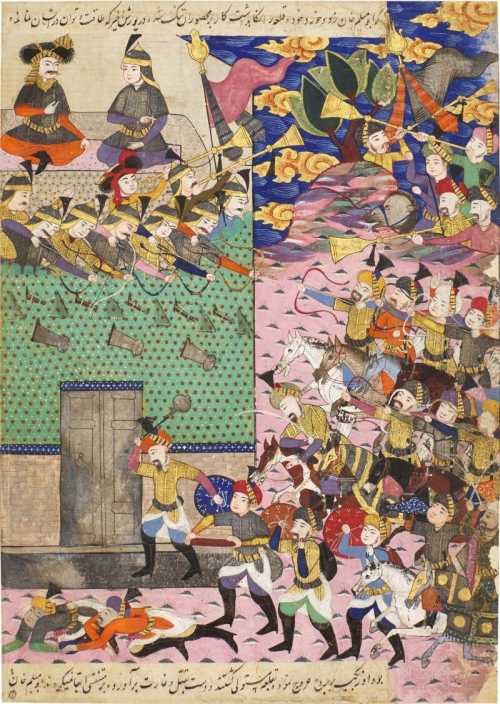
An illustrated and illuminated leaf from the Tarikh-i 'alam-ara-yi Abbasi of Iskander Bayg Munshi: the Uzbek army storms the fort of Isfarain, Persia, Isfahan, Safavid, circa 1650
Estimation
£15,000
19,634 USD
-
£25,000
32,723 USD
Realized Price
£20,160
26,387 USD
0.8%
Sale Date
Sotheby's
-
30 March 2022
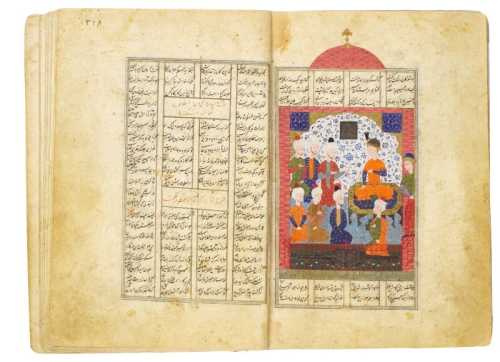
Nizami (d.1209), Khamsa, copied by Khwaja Mir ibn Shams al-Din Muhammad Munshi Astarabadi, Persia, Safavid, dated 966 AH/1558-9 AD
Estimation
£10,000
13,089 USD
-
£15,000
19,634 USD
Realized Price
£22,680
29,686 USD
81.44%
Sale Date
Sotheby's
-
30 March 2022

‘Abdullah Ansari, The Nasa’ih (Councils), copied by Shah Mahmud Nishapuri, Persia, Tabriz, Safavid, dated 953 AH/1546-47 AD
Estimation
£15,000
19,634 USD
-
£20,000
26,178 USD
Realized Price
£23,940
31,335 USD
36.8%
Sale Date
Sotheby's
-
30 March 2022
